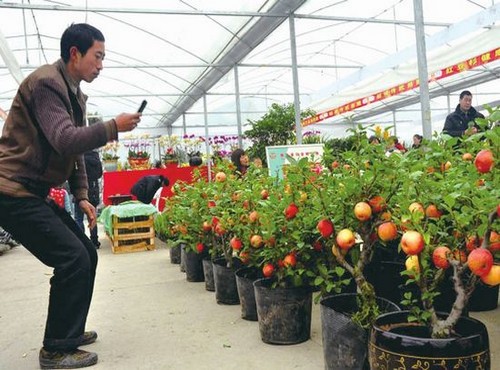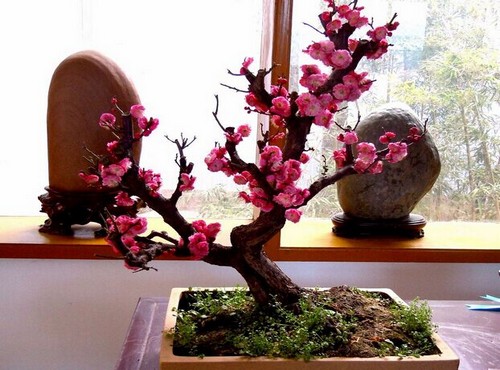Planting technique of Apple Bonsai
According to the shape of the stump, apples can be made into many different forms of bonsai, such as straight dry type, curved dry type, double dry type, oblique dry type, horizontal dry type, root raising type and so on. For young trees, the trunk can be modeled to make it tortuous and flexible. For the stump that lacks the state of aging, the method of splitting, carving or planing can be used to deal with the trunk in order to achieve a clear and quaint artistic effect.

I. selection of pots and allocation of nutritious soil
Choose caliber 40cm, bottom diameter 35cm, high 30cm tile basins, buckets and wooden boxes with drainage holes. The preparation of nutritious soil: 6 parts of fertile ripe soil, 2 parts of river sand, 1 part of rotten sheep dung, 1 part of retting leaves and horseshoe fermentative fertilizer, mixed evenly and sifted according to proportion.
2. Upper basin
The seedlings with strong plants, full bud eyes and no diseases and insect pests were selected and planted in the pot in the first and middle of April. When planting, the roots were soaked and disinfected with 5-degree stone-sulfur mixture, and the necrotic roots were cut off. First, a small amount of nutritious soil was loaded into the bottom of the basin and put into the seedlings. The root system will be distributed evenly, buried firmly, and watered in time, which can ensure survival.
III. Grafting
The apples used to make bonsai can choose those varieties with small plants, early fruiting, strong self-pollination ability, moderate fruit size and bright colors. The seedlings of begonia, bauhinia or apple were used as rootstocks, strong branches or plump buds slightly above the middle as scions, and grafted by split grafting, cutting grafting and bud grafting. Can also be used for many years of growth, strange and elegant shape of the old pile as rootstock, 1-3-year-old branch group as scion, grafting, this method can not only speed up the forming speed, but also bear fruit ahead of time.
The transplanting of rootstocks is carried out before sprouting in spring or after defoliation in autumn, first planted in a mud basin of suitable size, and properly pruned before planting, cutting off branches that are not needed in modeling, so as to reduce nutrient consumption and improve the survival rate. The root system should also be pruned, the thick main root should be cut off, and the lateral root and whisker root should be retained. The root with suitable thickness and length can be put into the basin first to prepare for the later root lifting.
It is allowed to grow in the first year after survival, so that the branches are fully developed and the root system is perfect. Grafting will be carried out in the second year and the branches on the rootstock will be cut off to ensure that there are sufficient nutrients for the growth of the scion.
IV. Panza
Apple branches are soft and resilient, and can be banded to 1-3-year-old branches in May every year to make them bend to a certain extent. because the branches grow downward or extend in parallel, the tip advantage can be removed. so that the plant gradually from vegetative growth to reproductive growth, which is conducive to the formation of flower buds. The root can also be raised according to the needs of modeling and the variety of rootstock, in which the apple bonsai grafted with Arbor-like rootstock is especially suitable for making root-lifting bonsai because of its developed and sturdy root system. Root lifting should be carried out year by year, step by step, and can not be completed at once. Fresh roots with suitable shape, thickness and length can also be selected and grafted by subcutaneous grafting. Make the roots natural, vigorous and simple.
Time: 2019-05-25 Click:
- Prev

How to increase the beauty of simple vicissitudes of plum blossom bonsai
The plum blossom bonsai is a work of art that uses pots as paper, plum blossoms, mountains and rocks as paintings, through artistic treatment and careful cultivation, to reproduce the divine appearance of plum in nature. Therefore, the plum blossom bonsai is a perfect combination of horticultural technology and plastic arts. It comes from nature and is higher than nature.
- Next

Cultivation techniques of bonsai in Zhu Dinghong
Zhu Dinghong, also known as Guting flower, its color can cover almost all the other colors in the chromatography except pure blue, pure black and pure green. The flower diameter can reach more than 20 cm, and the flower pattern has the changes of double, single, butterfly and so on. Some varieties have a velvety texture on their petals. In the eyes of the Zhu breeders,
Related
- Fuxing push coffee new agricultural production and marketing class: lack of small-scale processing plants
- Jujube rice field leisure farm deep ploughing Yilan for five years to create a space for organic food and play
- Nongyu Farm-A trial of organic papaya for brave women with advanced technology
- Four points for attention in the prevention and control of diseases and insect pests of edible fungi
- How to add nutrient solution to Edible Fungi
- Is there any good way to control edible fungus mites?
- Open Inoculation Technology of Edible Fungi
- Is there any clever way to use fertilizer for edible fungus in winter?
- What agents are used to kill the pathogens of edible fungi in the mushroom shed?
- Rapid drying of Edible Fungi

